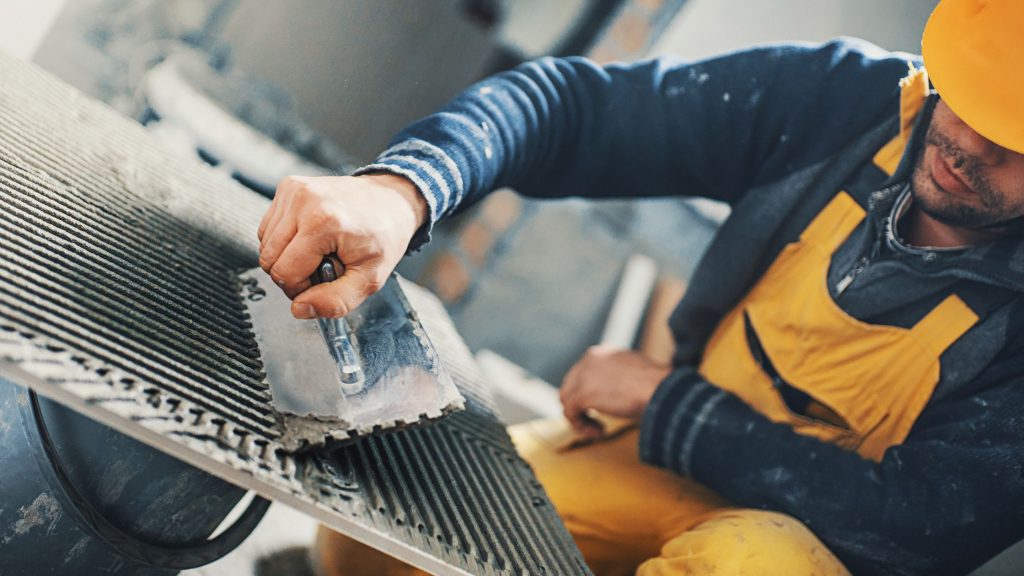When it comes to installing tile, it is very important that you follow a specific process to ensure that they stay put. Using the incorrect grout type, or adhesive can cost you hundreds of dollars down the line. Today we will walk you through picking exactly the correct kind of tile adhesive for your job, which materials are suitable for it, and typical techniques to keep in mind.
The Kinds Of Tile Adhesive Available
If you’re wondering what adhesive to use and where to use it, then the best location to start is understanding the different types offered. There are 2 popular adhesives that can be used when installing tile. The one you select eventually comes down to one of 3 considerations; if there’s moisture present in the tiled location, if there will be movement (i.e; floor covering), or if there will be heat. Listed below we check out the main ones so you can find the very best suitable for your project.
Pre-Mixed Adhesive:
Appealing as it may be to use this pre-mixed adhesive in your design for benefit’s sake, it is not a fit for all applications. Pre-mixed adhesives come all set made in a tub and in between the two adhesive options, it is among the most classics. This type of adhesive fasts to dry, and as soon as tile gets adhered to it, it can be a little bit of a discomfort to upgrade positioning. The latter works in favor of some styles.
While it isn’t perfect for lots of scenarios, there are a few in which it reigns remarkably. The very first is utilizing it for ceramic tile. The 2nd is when working against gravity, such as a kitchen area backsplash. The factor for the latter is that the pre-mixed adhesive starts to hold the tile before it even sets, which minimizes slippage.

As far as non-ideal scenarios, you must always avoid using pre-mixed adhesive in any area that wetness exists.
To work with mastic, spread the mortar quickly and twist the tiles into place. Working from the bottom up on walls, with a 2 x 4 to hold the bottom rows of tile in place, is recommended. If you need a hand with cutting tile, take a look at our guide here.
Thinset Mortar:
The second type of tile adhesive is thin-set mortars. Unlike pre-mixed adhesive, thin-set has a large range of applications which makes it a quite universal option. Though it doesn’t come blended in a useful way like its equivalent, it’s up to you to produce the mix to apply to tile.
Made from inorganic and products mined from the earth, this set is available in either a customized or unmodified variation.
The unmodified version is composed of cement, sand, and water retention representatives; The modified variation is composed of the same as noted prior to the addition of liquid latex polymers.
This type of adhesive is best utilized on floorings, or areas where moisture exists, such as outdoors or the restroom.
Shop Thinset Mortar
Know The Kind Of Tile Adhesive To Use
What tile adhesive to utilize on walls?
If you’re wondering what adhesive to utilize on walls, the response varies depending on the space the wall resides in.
When it comes to a cooking area backsplash or accent wall inside, then you can proceed and delight in the ever-convenient benefits of the pre-mixed adhesive.
Yet, if you’re placing a tile on the floor or in any area that contains moisture (outdoors, in the bathroom), you will wish to use thin-set mortar.
What tile adhesive to utilize on wood (floor covering)?
When it pertains to a particular kind of floor covering, such as placing tile atop wood flooring, we suggest using thin-set mortar. That stated it’s incredibly important that before you do any tile work, you position a tile support board on top of the wood or plywood. This will ensure an even surface level for application, warranting durability.
What tile adhesive to utilize on cement?
When it comes to utilizing tile adhesive on a cement surface area, it is best to utilize thin-set mortar.
If you’re placing tile adhesive over cement, then you need to ensure that all dust/debris is first eliminated from it to ensure that the adhesive sticks. Furthermore, you should ensure that you even the cement out so that it’s not sloping. A level surface area is ideal for the best results.
A Couple Of Tips and Tricks To Keep Useful
When it comes to placing the adhesive, here are a couple of tips that will assist simplify the task:
Make certain to speak with a specialist when you’re picking adhesives for floor tiles. While there are 2 main categories, there are also subcategories that can have a specialized type that’s best for you.
Bear in mind that floors go through heat, and high traffic. This need to be essential for selecting adhesive.
If you’re going to be placing on walls, in the kitchen area. use pre-mixed adhesive. If you’re placing on the floor, seek a strong thin-set mortar.
Use tile spacers when using thin-set mortar to keep from slippage because it’s a slower-to-set material.
That about finishes up this knowledge guide to tile adhesives. Do not hesitate to comment listed below with your own ideas or to ask questions! We ‘d love to speak with you.

